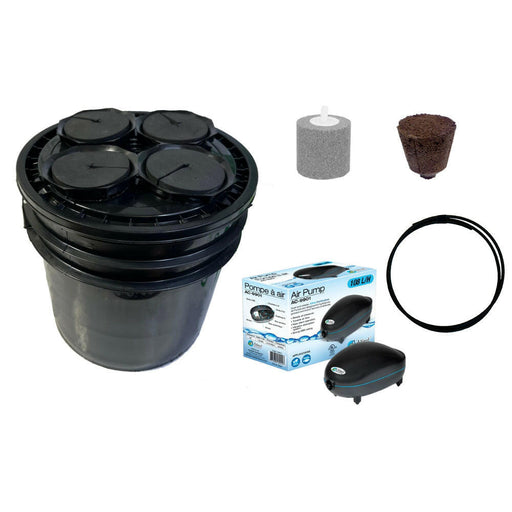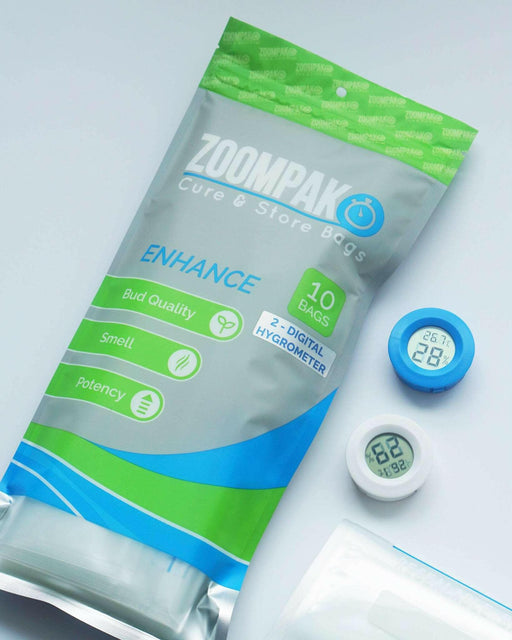
Why You Don’t Always Need a Chiller
We continue to receive questions about growing without a cooler, I've had plenty of successful grows without one and in this blog I provide some practical tips and real-world observations from one of my grows to explain how you can manage warmer root-zone temps safely and still get strong root development.
Skip the panic about warm nutrient temps Many growers insist nutrient solution must stay below ~70°F (21°C). That’s ideal — cooler water holds more dissolved oxygen and helps prevent root issues — but it’s not the only way to succeed. In my tent I run ambient temps up to 30°C (86°F) and nutrient temps around 74–78°F (23–26°C). It’s warmer than textbook “ideal,” but with the right practices the plants — and roots — can thrive.
Two key practices that make warmer temps work
- Maintain a sanitized reservoir
- Use reliable sanitizer products and keep the system clean. A sanitized solution reduces risk of pathogens and root rot that often take hold when oxygen levels are lower.
- Use enzyme supplements (e.g., Hydrozyme)
- Enzymes break down dead organics (root fragments, shed leaves) into simpler compounds that won’t rot and fuel pathogens. This protects root mass and converts potential problem material into usable resources for the plant.
- Enzymes help compensate for reduced oxygen availability in warmer water by preventing decay before it compromises roots.
What to expect and watch for
- Root health: With sanitation + enzymes you can still see dense, healthy root masses even when reservoir temps reach high 70s°F.
- Risk factors: Warmer water does reduce dissolved oxygen. Ideally aim for 64–70°F (18–21°C) when possible, but if you can’t, sanitation and enzymes are your best mitigation.
- Avoid complacency: Warmer systems require diligence — regular monitoring, cleanliness, and timely removal of debris.

Practical tips
- Keep the tent environment stable; excessive swings stress plants.
- Remove obvious organics from the reservoir and clean air stones and pumps regularly.
- Dose enzyme products according to manufacturer recommendations.
- If you can, prioritize chilling for sensitive crops but consider skipping a chiller for hardier varieties if you implement sanitation + enzyme protocols.
- Track results and adjust — many successful growers run without chillers using these methods.
Final thoughts You don’t strictly need a chiller to grow successfully, but success hinges on good hygiene and proactive management. Sanitation plus enzyme supplementation lets many growers run warmer nutrient temps without losing root health or yields. If you’re curious about switching away from a chiller or want a recommended product/dosing plan for your setup, tell me your system size and crop and I’ll suggest specifics. You can reach me at mitchell@visionaryhydro.com or send a message through our social media
You can watch the video about this topic by clicking below
Happy Growing!
Start Indoor Growing Today!
-
HydroCombo
Visionary HydroponicsOriginal price $76.45Original price $76.45 - Original price $76.45Original price $76.45Current price $57.34$57.34 - $57.34Current price $57.34Maximize your hydroponic gardening efficiency with the HydroCombo, an all-in-one solution for your Deep Water Culture needs. This high-quality comb...
View full detailsOriginal price $76.45Original price $76.45 - Original price $76.45Original price $76.45Current price $57.34$57.34 - $57.34Current price $57.34Save 25% -
HydroSeed
Visionary HydroponicsOriginal price $62.98Original price $62.98 - Original price $62.98Original price $62.98Current price $47.23$47.23 - $47.23Current price $47.23Simplify Starting Your Hydroponics Seedlings Introducing the HydroSeed, our all-in-one solution to go from seed to harvest effortlessly, and cultiv...
View full detailsOriginal price $62.98Original price $62.98 - Original price $62.98Original price $62.98Current price $47.23$47.23 - $47.23Current price $47.23Save 25% -
ZoomPak Cure & Store 1/2lb Bags
Visionary HydroponicsOriginal price $39.96Original price $39.96 - Original price $39.96Original price $39.96Current price $29.97$29.97 - $29.97Current price $29.97ZoomPak Cure & Store 1/2lb Bags - 10 Pack The ZoomPak Cure & Store Bags are designed for the discerning horticulturist seeking to pre...
View full detailsOriginal price $39.96Original price $39.96 - Original price $39.96Original price $39.96Current price $29.97$29.97 - $29.97Current price $29.97Save 25% -
HydroBucket
Visionary HydroponicsOriginal price $39.74Original price $39.74 - Original price $39.74Original price $39.74Current price $29.08$29.08 - $29.08Current price $29.08HydroBucket is the answer to your Deep Water Culture hydroponics needs.It streamlines your home growing experience, allowing you to focus on nurtur...
View full detailsOriginal price $39.74Original price $39.74 - Original price $39.74Original price $39.74Current price $29.08$29.08 - $29.08Current price $29.08Save 27% -
HydroLid
Visionary HydroponicsOriginal price $35.95Original price $35.95 - Original price $35.95Original price $35.95Current price $26.96$26.96 - $26.96Current price $26.96Premium Quality Hydroponic Lid for Optimal Fluid Movement and Plant Support The HydroLid is your essential tool for achieving optimal hydroponic gr...
View full detailsOriginal price $35.95Original price $35.95 - Original price $35.95Original price $35.95Current price $26.96$26.96 - $26.96Current price $26.96Save 25%





